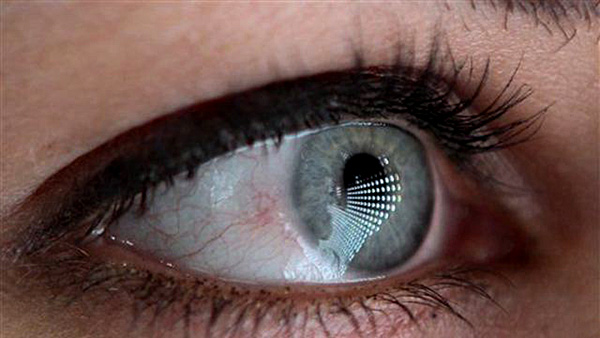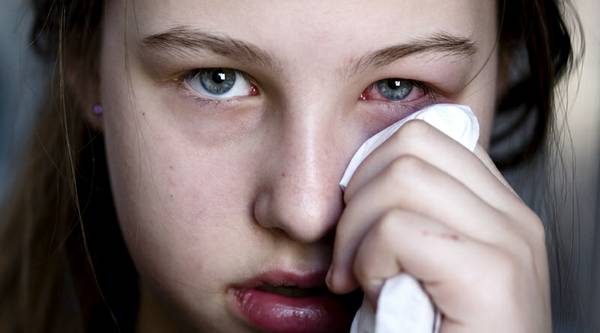Swollen eyelids occur when there is a swelling or excess fluid in the tissues around the eyes. Both upper eyelids and lower ones are affected, and in some cases you may feel pain in the eyes. The causes of this condition are infections, injuries or ocular trauma, but the most common are allergies. If symptoms persist, worsen or change, it is important to see your doctor for a thorough eye exam.
Symptoms of swollen eyelids:
Inflammation of the eyelids is a symptom of underlying cause such as an allergy or infection and is accompanied by one or more of the following signs:
– Irritation, with itching;
– Excessive tearing, watery eyes;
– Obstructing visibility zone, depending on the degree of swelling;
– Redness of the eyelids;
– Redness and inflammation of the conjunctiva (the mucous membrane that covers the inner surface of the eyelids and the anterior surface of the eyeball);
– A substance leaking from the eye;
– Dryness or peeling of eyelids;
– Facial swelling;
– Gene loss;
– Fever and headache;
– Pain, especially in infections.
What causes swollen eyelids?
There are many causes of eye inflammation, ranging from a slight allergy to the infections that can endanger the vision.
Eye allergies – It occurs when the immune system reacts excessively to a foreign substance called allergen. The most common causes are pollen, dust, pet hair, eye drops, contact lenses and makeup. These allergies can lead to dilation of blood vessels and swelling of the eyes; the eyes are red, itchy and watery.
Conjunctivitis – Is the inflammation of the lining of the eye surface (conjunctiva), which can lead to swelling of the eyelids, itching, tearing and redness.
Jug – usually appears as a red swollen bump on the edge of the eyelid due to bacterial infection. This condition can cause the entire eyelid swelling, which is usually sensitive to touch.
Chalazion – Is a condition that resembles the pitcher, but in this case the swelling increases away from the edge of the eyelid. Inflammation occurs after channel blocking excretion of sebaceous glands.
Eye injuries – Caused by an injury to the eyes, including the eyelids concussion or trauma caused by cosmetic surgery that can trigger inflammation of the eyelids.
Contact lenses – They can irritate eyes, only in case of improper care. Swollen eyelids can be caused by damaged or soiled wear lens and keeping them in an inappropriate box.
Blepharitis – This is the inflammation of the eyelid and usually is caused by the malfunctioning glands. This disorder is characterized by swollen and painful eyelids, which may be accompanied by loss of eyelashes and eyelids peeling. Blepharitis is a chronic disease, so symptoms can be alleviated with proper treatment and proper hygiene, but will never be fully cured.
Orbital cellulitis – A rare bacterial infection that affects badly the tissue around the eyes, leading to painful swelling of the upper and lower eyelids, and possibly of eyebrows and cheeks. Other symptoms include bulging eyes, decreased vision, fever, eye pain upon eye movement. Orbital cellulitis is a medical emergency that requires treatment with antibiotics to prevent damage to the optic nerve, permanent vision loss or other serious complications!
Ocular herpes – Causes inflammation and sometimes scarring of the cornea. Symptoms include pink eye, painful lesions on the eyelids, blurred vision and swollen eye. Types of herpes can vary from a mild infection to a serious health problem that could lead to a corneal transplant or even blindness!
Graves’ disease – It is the most common cause of hyperthyroidism and consists of excessive secretion of thyroid hormone. It has three major symptomatic manifestations: hyperthyroidism with diffuse goiter, ophthalmopathy and dermopathy. The three events may not occur together, and their evolution can be independent. In terms of eye disorders, Graves’ disease is often associated with swollen eyelids, bulging eyes, double vision, and abnormal movement of the down eyelid. If any of these symptoms occur, you should consult a doctor for proper diagnosis and treatment.
Treating inflamed eyelids:
Treatment depends primarily of the type of inflammation and their cause. An ophthalmologist may recommend or prescribe appropriate medications such as eye drops.
If case of allergies, to relieve symptoms are used eye drops or medications to counter antihistamines. For other causes, such as infection with herpes or conjunctivitis, are used antibiotics, antiviral or anti-inflammatory drops or ointments.
– Minor illness that causes inflammation of the eyelids can be treated at home. Avoid to rub your eyes because it will aggravate this condition.
– If you wear contact lenses, leave them aside until the problem is resolved.
– Avoid applying any makeup on the face and eyelids, it can further irritate.
– Sprinkle your closed eyelids with cold water and apply compresses soaked in ice water, which will reduce inflammation and constrict blood vessels.
– You can relieve swelling around the eyes dabbing the skin with a piece of gauze soaked in milk.
– Cool and slice a cucumber, then place a few slices on the closed eyelids, then leave on for ten minutes.
– Apply green, black or chamomile tea bags on your eyelids and let them ten minutes. Prepare them by dipping them in cold water for 15 minutes, then squeeze out the excess liquid.
How to prevent inflammation of the eyelids:
To prevent inflammation of the eyelids, first you need to check if you’re allergic to something, especially if you often have swollen eyelids. If you know what causes the sensitivity, you will be able to protect yourself, limiting the exposure to specific allergens.
– Choose hypoallergenic and unscented makeup and beauty products. Before using the product, make a test on the inside of the wrist to prevent any allergic reaction.
– When using eye drops, choose the ones without preservatives. Even if they inhibit bacterial growth, some people may be allergic to preservatives.
– Always remove your makeup before bedtime to prevent blockage of the eyelid glands. Use makeup based on minerals.
– Sit on a pillow when you sleep. Keeping your head elevated higher than the body discourages the accumulation of fluid in the eye area at night. Also, whenever possible, sleep on your back.
– If you wear contact lenses, minimize the risk of infection or irritation by practicing proper hygiene techniques. Replace your contact lenses frequently and the support you keep them into.
By following these tips, you’ll be able to treat and prevent inflammation of the eyelids.

